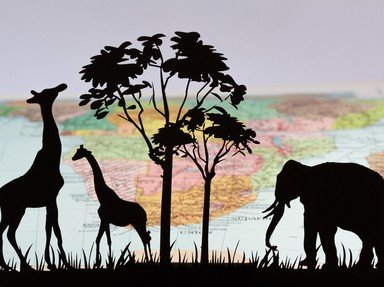Quiz Answer Key and Fun Facts
1. From the relative safety of the safari vehicle The Trivia Winners spot their first wild animal. With binoculars out they realize that they have stumbled across a gnu. One of the members of the safari team wonders if the gnu has another name. The guide tells us that the gnu is indeed known by another name, but what is it?
2. Moving on we found another animal coming out of a burrow. This is that first animal of the alphabet, the aardvark. His long snout and excellent sense of smell are just perfect for devouring his favorite meal, ants and termites. To what animal is the aardvark closely related?
3. As we move along the Savannah, The Trivia Winners spot a camelopardalis (Latin for camel leopard). Our guide tells us the animal is older due to the darkness of his spots, and male because of his bald horns. We are also told that he only requires a couple of hours of sleep a day and has excellent eyesight. The females of the species travel in herds and the calves can actually run within a few hours of birth! We marvel at his beauty as he eats leaves from a nearby acacia tree. Do you know which animal we are happily watching?
4. From our Trivia Winners safari boat, we spot a pod of water-loving animals who look like giant pigs. Adults sink to walk along the bottom of the river, babies ride on the backs of their mothers, and some even sleep underwater. We want a closer look. Our guide says, "No, pasop vir seekoeie! Beware!" This animal will attack crocodiles, lions, hyenas, people and even boats! Which massive creature has stubby legs, but is most closely related to a whale and a porpoise?
5. White and black are the two species of rhino found in Africa and are both endangered because of hunting and poaching. Some cultures believe their horns have magical qualities. Their horns, however, are really...
6. I see some animals up ahead and there are quite a few of them living together. They are meerkats, each of them seems to be performing particular duties in the community. What North American animal has a similar social structure?
7. Although most of our attention has been on the ground, a brightly coloured bird landing on top of an isolated tree catches our eyes. Its bill is black, its eyes are brown, and it has large wings. A second one appears, in a fast shallow dive with a distinctive rocking motion, making loud raucous calls. What is the name of this breed of bird?
8. Our guide on the savannah cautions us to never stop for a rest against a tree as we may fall victim to an arboreal attack by Africa's most feared reptile. This snake is the fastest in the world, capable of covering ground at speeds of 20 km/h, and averages an impressive 2.4 meters in height. The neurotoxicity of this snake's venom is so high that respiratory paralysis is followed by death within an hour of several nasty bites (this snake is a repeat attacker). If you have the antivenin handy, you should be just fine! Which African snake has garnered this ferocious reputation, but in actuality avoids human contact unless provoked or threatened?
9. Probably the most amazing thing about Acinonyx is its ability to accelerate from 0 to 100 km/hr (63 mph) in 3 seconds! Experts speculate that during the last ice age this species had to endure prolonged inbreeding to survive resulting in weakness in gametes and leaving them genetically fragile. Acinonyx males tend to be social and form "coalitions" with other males for life while females will tend to hunt alone. Which beautiful cat are we observing?
10. While we hike the amazing Atlas Mountains, our guide tells us of the Shimera, now extinct. It was the only native of this type in Africa. The Romans used it in execution games, and then it was hunted down for sport. A hunter killed the last one around 1845. Relatives of this stocky, acorn-eating beast still live on other continents. Don't run if you make one mad! Which African mammal is lost to us forever?
Source: Author
jonnowales
This quiz was reviewed by FunTrivia editor
crisw before going online.
Any errors found in FunTrivia content are routinely corrected through our feedback system.

